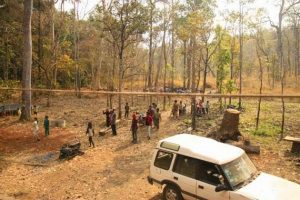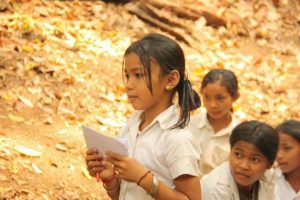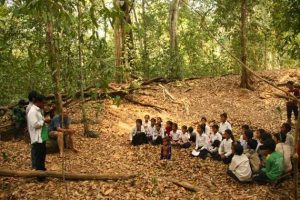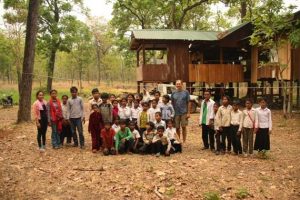Our whole family is introverted: Amelie perhaps the least so. So when we hear that a group of people are coming to visit, we get a little apprehensive. Khmers, on the other hand, are probably the most sanguine, extroverted people in the world. None can imagine living out in the middle of nowhere. Don’t we get bored?
Last month, someone called Ben and told him that they wanted to bring a bunch of students from the district town to visit the forest. This is good (despite our preference for solitude): an opportunity to show the locals what we are doing and hopefully to encourage the little part of “conservation” that should be in all of us. Wel,l the bunch of students turned out to be about two hundred miscellaneous people coming out for a day of “dar-laing.” A popular Khmer word literally translated as “play-walking” and meaning to go on an outing. And when Khmer people go dar-laing they ALL go dar-laing. They mostly arrived in small groups on motorbikes, trickling in.
Sitting everyone down at the outset was a little difficult – impossible. We had wanted to let everyone know the rules (what to do with garbage mostly) but it was too hard. We were not prepared! By the end of the day all four of us were exhausted. Amelie was a great host showing the kids how to play on her swing and monitoring the trampoline. Jarrah pretty much hid all day! The rest of the week, we spent clearing up litter, which our visitors had not been impressed upon, to place in the bins. Failure!
So yesterday, when we heard that our village’s primary school was coming out, it was with a mix of trepidation and delight that we welcomed them. We were so very encouraged that the teachers had initiated this outing with the goal of helping the fourth through six graders to understand what a community forest is. Trepidation caused by our past experience. We were pleasantly surprised. The kids were polite. The teachers organised. Each child had to contribute money for their lunch and the teachers cooked them their picnic lunch. The kids came prepared with questions about the community forest: What was the purpose of the community forest? What the goals were? What the benefits of keeping a community forest were? How big was the community forest? They sat and listened as Ben explained that this forest was for them. That soon, all around there will be no other forest as people develop agriculture and the land is sold off. That soon, if we don’t conserve just a little bit, there will be no people who know the names of the trees, or the animals who make this forest their home, and that so many resources that they get from the forest will no longer be available. We hope that these children will be able to take home just a bit of what they learned. And maybe there will be a little spark in them that can smoulder, allowing them to understand and value our conservation efforts, and contribute themselves. It will take more than just a single outing though. It seems that this generation, before they get old enough to be cynical and stuck doing just what will benefit them now only, that they need to be exposed to different ideas that will maybe help them to think they can conserve rather than destroy. Just need to operationalise a program!



